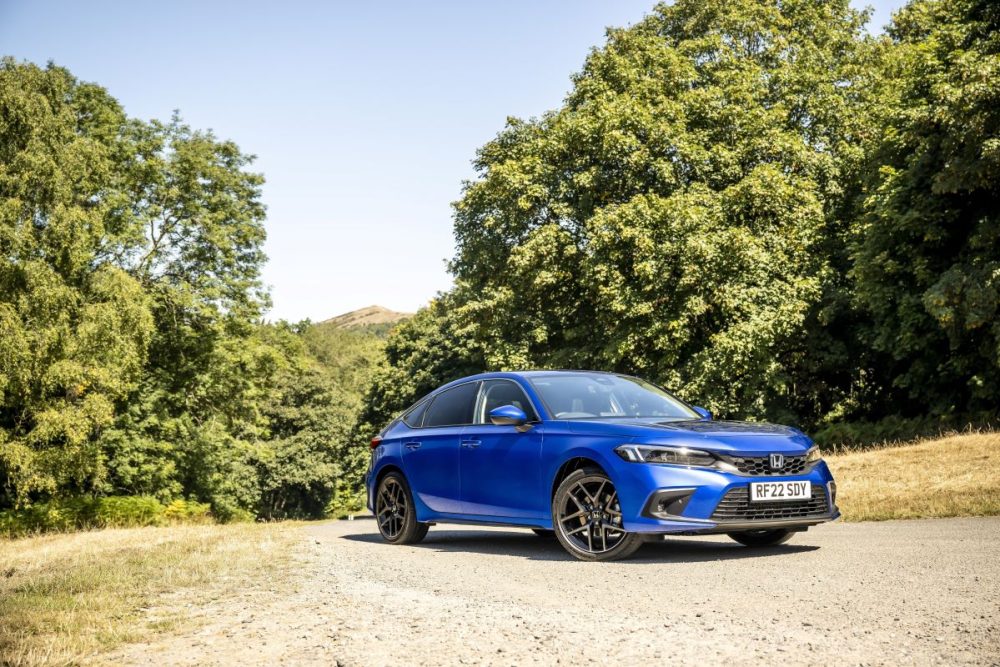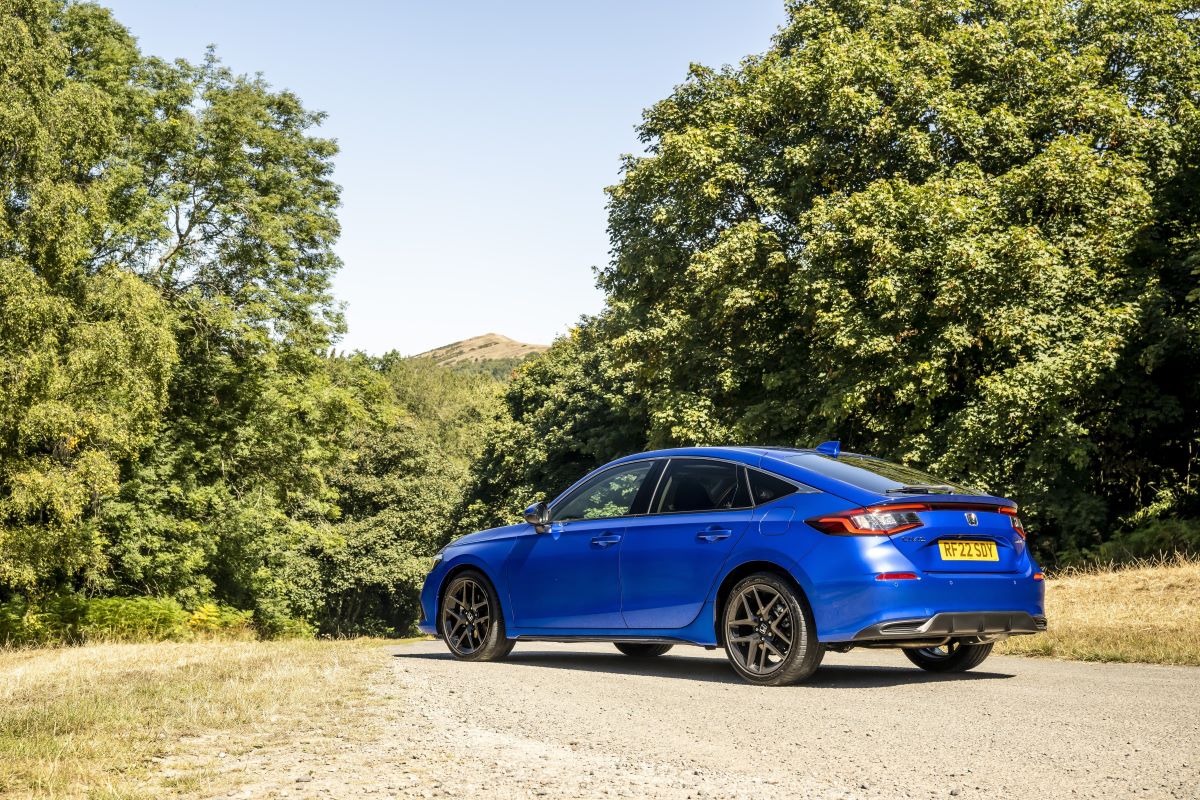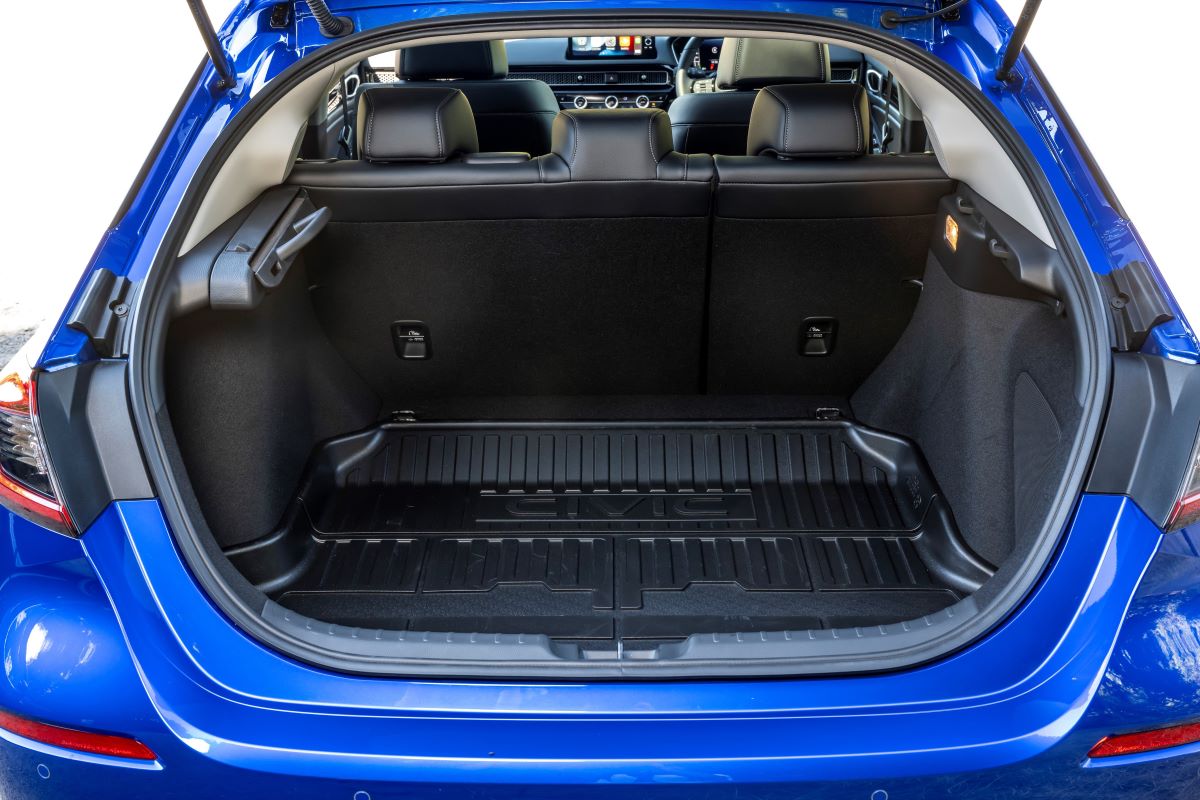What is it?
Probably the best known name in the Honda fleet, and one that’s been around for 50 years. First introduced in 1972, Honda has always defined the Civic as its ‘car for people of the world’.
Since 1972 over 27.5 million units have been sold across 170 countries and this, the 11th generation Civic, represents a modern evolution of the model’s distinctive shape with a cabin boasting greater comfort, visibility and spaciousness.
Honda’s proven e:HEV powertrain technology comes as standard, completing the brand’s mission to electrify all its mainstream European models by the end of 2022. The hybrid powertrain uses a lithium-ion battery to power two compact electric motors that work together with a 2.0-litre direct-injection petrol engine. It offers stunning all-round performance through impressive energy density, thermal efficiency, and torque.
Thanks to a tailored application for the new Civic, the e:HEV system is smoother with a more responsive power delivery and a greater sense of linear acceleration, as well as offering exceptionally high fuel efficiency and low CO2 emissions.
The new infotainment system has been designed to enhance comfort, convenience, and safety, with Apple CarPlay and Android Auto available as standard. For the first time in a Civic, top grade Advance models will be equipped with a 10.2-inch fully digital instrument panel that offers users a range of customizable displays to relay the most relevant information to them.
The latest Civic also features Honda’s expanded SENSING suite of advanced safety features and driver aids, which have been improved specifically for this new model. The introduction of new smart driver aids and active safety technology, in addition to an increased airbag count and new structural components designed for improved collision protection, ensure optimum safety for both driver and passengers.
To create a sportier coupe-like look, the new Civic’s wheelbase is 35mm longer than the previous model, but with a 20mm shorter rear overhang and reduced overall height. The highest point of the roof line is set further forward than the previous model, with a gentle slope to the tailgate completing its sleek look. The resin tailgate – developed through new manufacturing technology – is 20% lighter than its predecessor and is crucial for achieving the sleeker design without impacting on rear head space.
The front of the Civic features a sharper bumper design than the previous model, integrating a mesh pattern in the upper grille that emphasises a sportier look. Black garnish on both sides of the lower bumper has been repositioned to give the car a lower, more planted appearance. At the rear, the tailgate deck height and combination taillights are positioned lower than the current Civic.
The rear ends of the hood have been lowered by 25mm, with the A-pillars 50mm further rearward, to align with the centre of the front wheels, giving the car a more balanced proportion in profile as well as a wider, more assured stance from all angles. This also has the effect of making the wheels and tyres appear larger, which, combined with the wider rear track and hemmed wheel arches – which helps reduce the visual gap between wheel and arch – creates a lower, more assured stance and projects a sense of greater agility. Despite the wider track, the overall vehicle width remains 1,800mm, the same as the previous model.
A range of alloy wheel designs are available with a 17-inch aluminium wheel as standard on Elegance grades, while 18-inch wheels are fitted to Sport and Advance grades; the latter gaining a two-tone finish.
What do we think?
The new Civic has a cool, sporty look and once you sit inside things don’t disappoint either. There’s greater comfort, visibility and spaciousness and an altogether more premium feel to its predecessor. The user-focused layout features high quality materials and an uncluttered instrument panel. Tactile touchpoints further enhance the experience for drivers and passengers, with spring force in the buttons carefully moderated to emulate the feel of operating high-end home appliances.
The centre console features two cup holders positioned in parallel to the shift lever. In front of which, sits a large sized tray that can accommodate – and charge – the largest Apple smartphone. The herringbone black areas of the centre console (and door cards on Advance models) are coated in a scratch and fingerprint resistant finish to ensure a lasting, beautiful finish. The large central storage box now features an arm rest with a mechanism that pops open the top automatically to 60 degrees.
Seats feel comfy enough and two interior seat designs are available: black with seamless accents and black with white stitching. Fabric seats are standard on Elegance grade models, while the higher-grade Sport comes with a combination of fabric and synthetic leather as standard, whilst Advance grades feature a leather and synthetic leather combination trim.
Despite a lower roofline, interior headroom and cabin space remain the same as the previous model by moving the tailgate support hinges outward from previous generation. The new Civic’scargo area has comparable load capacity as the outgoing model – among the largest in its segment – but with a wider tailgate aperture for improved usability. With impressive boot capacity from over 400 litres (to the window line), the all-new Civic can accommodate a wide variety of luggage and equipment.
Also nice to see a car company eschewing the now thoroughly outdated, yet ubiquitous, cargo cover, suspended by bits of string from the tailgate. The Civic features a neat slide away cover which adds to the premium feel of the car.
Civic’s upgraded Honda infotainment system is accessed via nine-inch touchscreen or through voice control. The controls and menu layers are optimised to minimise up-and-down eye movement to promote simple and fast operation. A finger rest for the touch panel stabilises the user’s fingertip even when the vehicle is in motion, with the six customisable shortcut options now placed just above for easy access to functions such as the navigation system, phone, and audio. Physical buttons for ‘Home’ and ‘Back’ operations and the audio control dial have been enlarged, making them easier to use while driving.
An advanced navigation display has been designed with new graphics to minimise driver distraction through clearer presentation of information. The system now accommodates the introduction of 3D urban modelling with improved image quality.
For the first time in a Honda, a customisable 10.2-inch full colour digital binnacle is standard on top spec models, with lower grades featuring 7.0-inch meter-display dials. Both options feature new instruments that detail power output and regeneration levels within the e:HEV hybrid powertrain. Audio-related information is consolidated on the left side of the screen, while driving-related information such as Honda SENSING and navigation information is positioned to the right of the display. This positioning helps the driver to intuitively operate the relevant steering wheel-mounted controls.
Elegance and Sport grades include eight speakers as standard. The Advance grade features a premium 12-speaker BOSE ‘Centrepoint sound system, offering occupants improved levels of immersion when listening to music. The technology is the result of a joint development between sound experts from Honda and BOSE.
On the road the new Civic has been given increased body rigidity for improved handling while power steering and updated Agile Handling Assist have been tuned for European roads
Improved cornering stability has been achieved thanks to a 35mm longer wheelbase and 18mm wider rear track compared to the car’s predecessor. Steering input delay has been reduced through reduced friction of the damper mount bearing and ball joint friction resulting in reduced steering friction by 28% over the previous model.
Other dynamic enhancing revisions include the use of a lightweight and highly rigid aluminium front subframe, revised front dampers and the reduction of damper rod friction.
Under the bonnet, Honda’s e:HEV hybrid technology has been upgraded, producing a total power output of 135 kW, and an impressive 315 Nm of torque, which equates to 0-62mph acceleration in 7.8 seconds. Notable improvements extend into real-world efficiency, with the updated e:HEV producing CO2 emissions from 108 g/km (WLTP) and achieving a fuel economy of 4.7 L/100km (WLTP). In the UK that translates to 49.9mpg over the 320 miles we covered with the car.
The full-hybrid powertrain combines a power-dense lithium-ion battery and two compact, powerful electric motors with a newly developed 2.0-litre direct-injection Atkinson-cycle petrol engine. The e:HEV system shifts without notice between EV, Hybrid and Engine Drive with no input from the driver.
When driving in an urban environment the vehicle runs in EV Drive most of the time, producing zero emissions whilst utilising the seamless and responsive traits of electric drive. When the driver requires stronger acceleration, the car will switch to Hybrid Drive to propel the wheels via the powerful electric motor, with the internal combustion engine generating the required electric power.
When driving at constant high speeds, such as on the motorway, the system will shift to Engine Drive, and is directly and efficiently powered by the petrol engine with minimum losses and assisted by the electric motor when necessary. When the required drive energy becomes high towards top speed, the system switches back to Hybrid Drive to unleash the full output of the electric motor.
In all drive modes, brake and deceleration energy is being recuperated to improve the overall efficiency resulting in remarkably low fuel consumption particularly in stop and go traffic. Thanks to the high rigidity of the crankshaft and the secondary balancer shaft, the engine has lower vibrations over the entire engine speed range than in previous generations of the e:HEV system, enabling a smooth drive in all drive modes.
The evolution of Honda’s e:HEV hardware over 20 years has resulted in a sophisticated yet compact and efficient power unit that combines the responsiveness and power of an electric motor, with the long-range refinement of a petrol engine to impress in both urban and rural driving. It not only provides instant response when accelerating at low speeds but also at high speeds on the motorway.
Using a drive selector, users can switch between four drive modes: ‘Normal’, ‘Sport’, ‘Eco’ and ‘Individual’. Sport mode sharpens throttle response and improves performance, while Eco mode adjusts throttle response to improve fuel efficiency. The new Individual mode allows users to tailor the Civic’s characteristics to suit their driving style, including steering weight and throttle response. At any time, users can switch back to Normal mode, where the car provides a set-up that balances performance and efficiency.
In terms of safety and driver assitsance, The Honda SENSING system has a range of additional safety features compared to the outgoing Civic, and some of the existing functions have been significantly improved. Sonar sensors debut in the new model, with four at the front and four at the rear, the sensors use the reflection of sound waves to detect non-metallic objects such as glass and walls far more reliably and with far greater accuracy than the millimetre wave radar that was previously used. The new Civic is also fitted with the front wide view camera. It provides a wider 100-degree view and enables enhanced recognition technology to improve the Civic’s capability to identify road lines, verges, motorcycles, and cyclists.
A new high-speed processing chip has been used to improve the detection, performance, and control of the system, meaning the Honda SENSING system can detect objects earlier and more accurately than conventional millimetre radar systems, including pedestrians in light and dark environments.
The Forward Collision Warning System is designed to detect the presence of vehicles in front of the vehicle, and issues audible, visual and tactile alerts to the driver if approaching with too much speed. If the driver fails to respond, the Collision Mitigation Braking System is triggered, which automatically applies light brake pressure to help reduce the likelihood or severity of a frontal impact. If the updated system senses imminent collision, it will brake forcefully. Cross Traffic Monitor also benefits from improved radar sensors, enabling the Civic to warn the driver sooner about cars approaching from either direction when reversing from a parking space or driveway.
On the road, the radar allows the Civic to scan each side of the vehicle from the front doors backward, helping to increase the range of the blind spot detection from three metres to 25 meters. When recognising a vehicle occupying the adjacent lane – or approaching diagonally from behind at a significant speed, the system will display a visual warning on the side mirrors when it comes into a range of approximately 25 metres or less, improving safety for drivers looking to switch lanes at high speeds.
For the first time, the new Civic is equipped with Traffic Jam Assist. This reduces the driver’s workload in low-speed congested traffic by helping to keep the vehicle in its lane, starting from 0 km/h. When traffic congestion clears, from around 60km/h the system seamlessly switches to the Lane Keeping Assist System, a lower speed than conventional systems.
Benefiting from the new camera set-up, the updated Adaptive Cruise Control system can detect vehicles much earlier and more accurately than before, enabling progressive acceleration and braking for a gradual and more human reaction. When overtaking a car, the system works in conjunction with the indicator and steering operation to provide strong acceleration depending on the specific driving situation. When a slower vehicle leaves the lane ahead, the system gently accelerates back up to the speed set for the Adaptive Cruise Control. It also responds more quickly when changing into an open lane from behind a slower car, and when a slower car moves out of the lane ahead.
Honda Civic e-HEV Sport from £36,495 – Advance from £39,795
Engine Maximum Power 143ps
Engine Maximum Torque (NM at rpm) 186Nm
Electric Motor Max Torque (Nm) 315Nm
0 → 62 mph (seconds) 7.8
Max Speed (mph) 111
Fuel economy (on test) 49.9mpg
CO2 96 g/km











